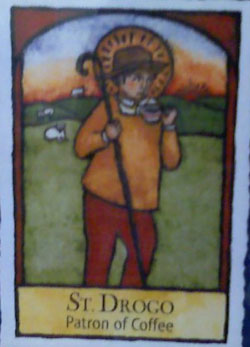
Feastday: April 16
Patron: those whom others find repulsive, unattractive people, Baume-les-Messieurs, bodily ills, broken bones, cattle, coffee house keepers, coffee house owners, deaf people, deafness, dumbness, Fleury-sur-Loire, gall stones, hernias, illness, insanity
Birth: 1105
Death: 1186
Flemish noble orphaned at birth who became a hermit, also called Droun. He became a penitential pilgrim, visiting shrines, and then became a shepherd at Sebourg, France. Stricken with an illness that made him physically repulsive, Drogo built a hut at Sebourg and stayed there as a hermit for forty years. He is a patron of shepherds.
Drogo of Sebourg (March 14, 1105– April 16, 1186), also known as Dreux, Drugo, and Druron, is a Flemish saint. He was born in Epinoy, Flanders, and died in Sebourg, France. His is known as the patron saint of shepherds, coffee, and the ugly, and his feast day is on April 16.
Life
Drogo was a child of Flemish nobility. His mother died when he was born. He learned the reason for her death, and it made an emotional impact on him. He held himself responsible. Later in his life, he went to extreme penances, perhaps to relieve his guilt. Drogo was orphaned when he was a teenager.
At age eighteen, he rid himself of all his property and became a penitential pilgrim. As a pilgrim, he traveled to Rome about nine or ten times. He became a shepherd for about six years, working in Sebourg, near Valenciennes, where he worked for a woman named Elizabeth de l'Haire.
Reportedly, Drogo was able to bilocate, to maintain his actual presence in two totally different places at the same time. Witnesses claimed seeing Drogo working in fields simultaneously, and going to Mass every Sunday.
During a pilgrimage, he was stricken with an unsightly bodily affliction. He became so terribly deformed that he frightened the townspeople. In his twenties, a cell was built for him to protect the local citizens of the village from his appearance. Since he was so holy, his cell was built attached to his church. Drogo stayed in his cell without any human contact, except for a small window in which he received the Eucharist and obtained his food. He stayed there for the rest of his life, about forty more years, surviving on only barley, water, and the holy Eucharist.
Controversy
Although Drogo is now regarded as the patron saint of coffee, this patronage is anachronistic. There is no evidence that a pilgrim from Flanders in the 12th century had any connection to a drink associated with Ethiopia and the middle East in the 15th century. As Mark Pendergrast writes in his scholarly text "Uncommon Grounds: the History of Coffee and How It Transformed Our World" (2019), “Though Rhazes and Avicenna may have been writing about some form of coffee, they were not describing our brew. It probably wasn’t until sometime in the fifteenth century that someone roasted the beans, ground them and made an infusion.”
It's also worth noting that there are no primary sources on Drogo's life, and that the books and sites listed on this page are drawn primarily from the work of a Catholic writer, Joan Carroll Cruz, who in two books, "Lay Saints: Ascetics and Penitents" and "Mysteries, Marvels and Miracles: In the Lives of the Saints" gives brief overviews of Drogo's life with no scholarly sources.

